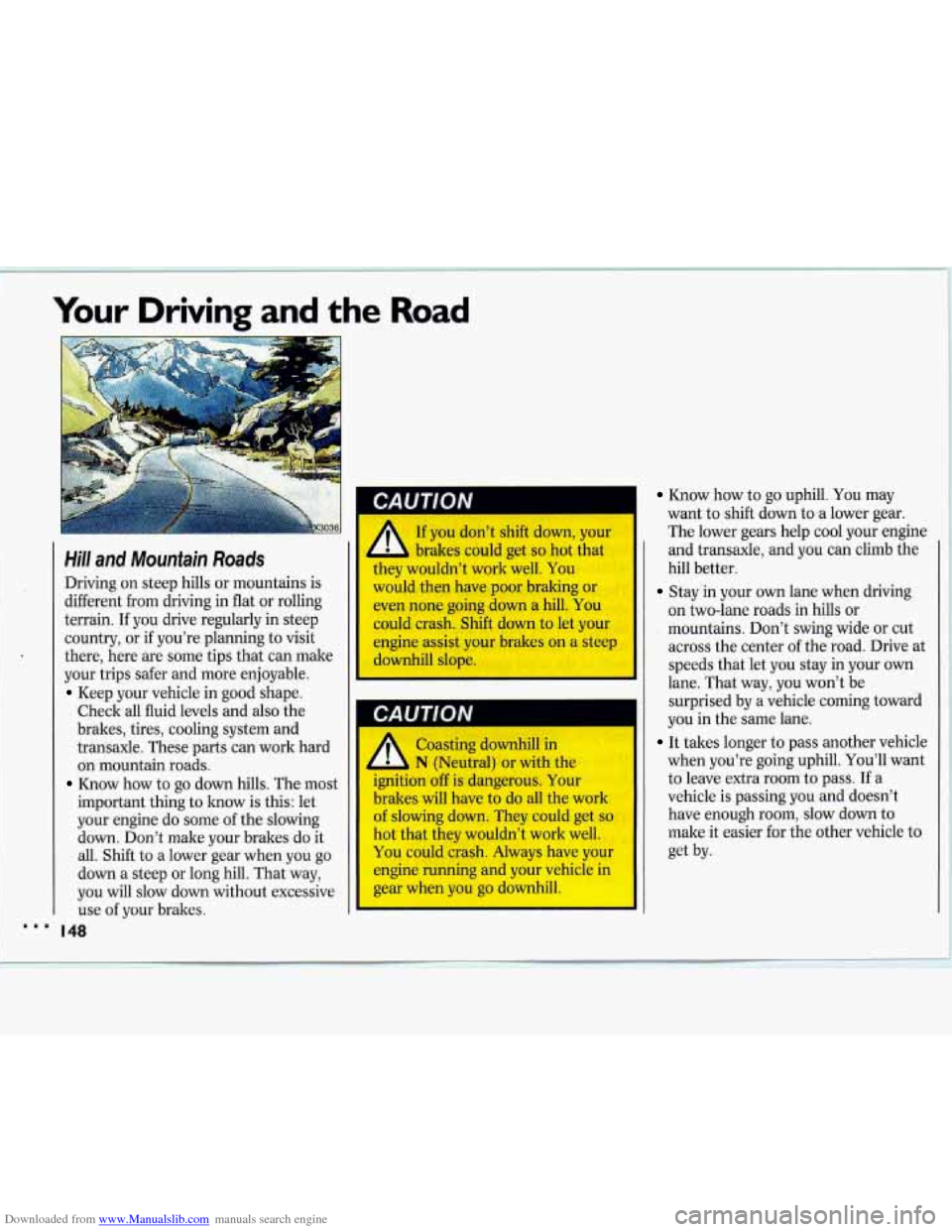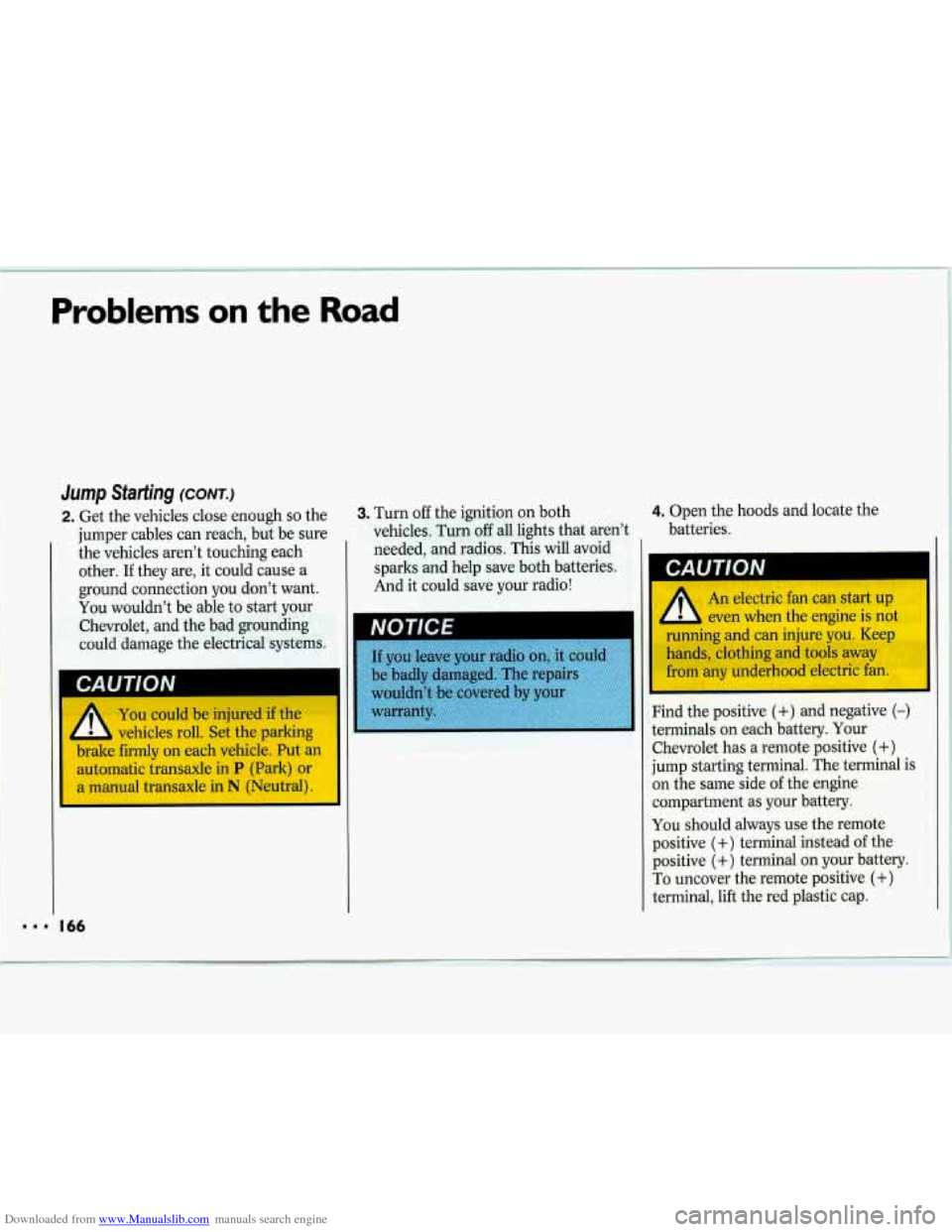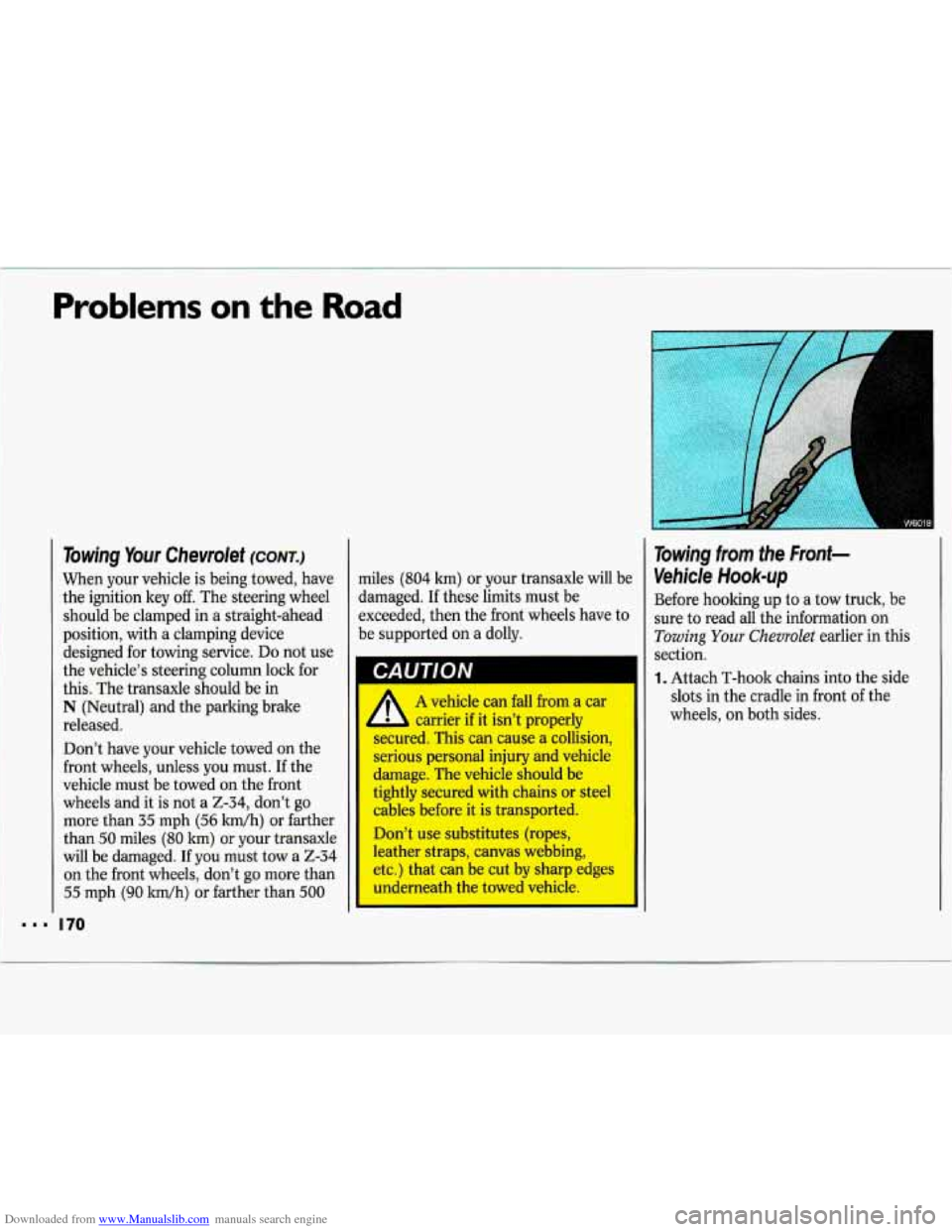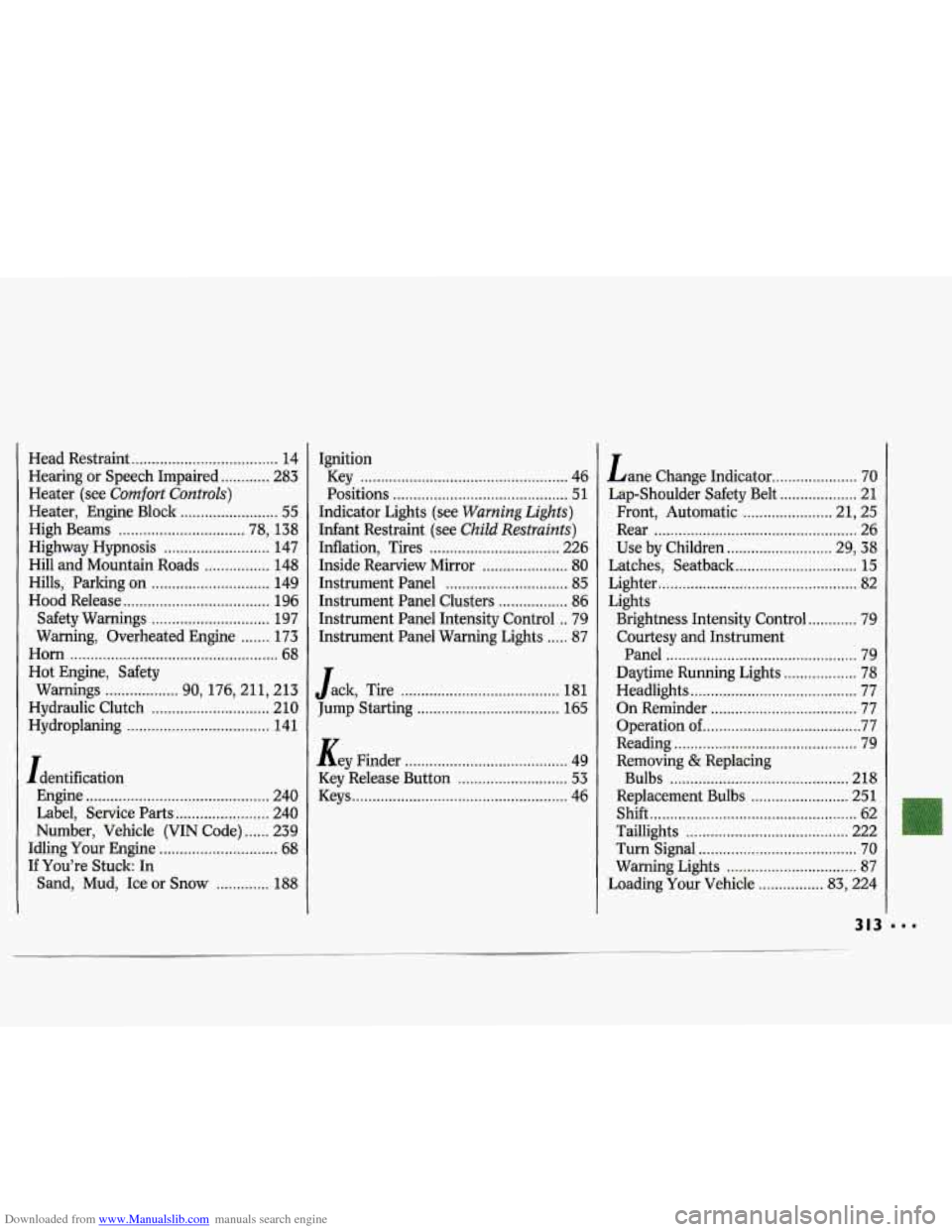1993 CHEVROLET LUMINA ignition
[x] Cancel search: ignitionPage 112 of 324

Downloaded from www.Manualslib.com manuals search engine Comfort Controls & Audio Systems
AMIFM Stereo with Compact Disc
Player
The digital display indicates information on time or radio station frequency, the
AM or FM radio band, whether the
station is in stereo, and other radio
functions.
PWR-VOL (Power-Volume) : Turn
the upper knob to turn the unit on and
off when the ignition is on and to adjust
the volume up or down. The control behind
the upper knob lets
you adjust left-right speaker balance.
TUNE: Turn the lower knob to tune in
higher frequencies and lower
frequencies. Press the hob to switch
between the AM and FM bands.
The control behind the lower knob lets
you adjust the front-rear speaker
balance.
SEEK: Press to tune automatically to
the next station higher or lower on the
band. Press
SEEK, to tune stations
higher on the band. Press
+SEEK to
tune stations lower on the band.
SCAN: Press to listen for a few
seconds to the next station on the AM
or
FM band. The scan will continue
every few seconds until you press
SCAN again to stop on a particular
station.
RCL (Recall): Press to change
between the clock and the radio station
frequency displayed on the digital
screen.
BASS: Press up or down to increase or
decrease the bass.
TREB (Treble): Press up or down to
increase or decrease the treble.
110
Page 114 of 324

Downloaded from www.Manualslib.com manuals search engine Comfort Controls & Audio Systems
'I
AMIFM Stereo with Compact Disc
Player (CONT.)
RCL (Recall): Press once to see which
track is playing. Press again within five
seconds to see how long your selection
has been playing. The track number
also will be displayed when the volume
is changed or a new track starts to play.
PRFN (Previous): Press to play a
track again.
If you keep pressing PREV,
the disc will keep backing up to
previous tracks.
NEXT: Press when you want to hear
the next track. If you keep pressing
NEXT, the disc will keep advancing to
other tracks.
I I2
REV (Reverse) : Press and hold to
rapidly back up to a favorite passage.
Release to resume playing.
FWD (Fast Forward): Press and hold
to rapidly advance the disc. Release
to
resume playing.
SCAN: Press to sample each track for
about ten seconds. Scanning
will
continue until you press SCAN again.
RDM (Random): Press to allow the
CD player to play the tracks in a
random order.
COMP (Compression): Depressing
this button makes
soft and loud
passages more equal in volume. Press
again to resume normal play.
When Finished with the Compact I
Disc Player:
If you turn off the power or turn off the
ignition, the disc will stay in the player
and start again when you turn on the
ignition or power switch. The disc will
begin playing at the point where it had
been stopped.
ST-PL (Stop-Play): Press to stop the I
disc player; the radio will play. Press
again to play the disc (the player will
start playing the disc where it was
stopped earlier).
EJCT (Eject): Press to eject the disc;
the radio will play.
Page 150 of 324

Downloaded from www.Manualslib.com manuals search engine Your Driving and the Road
CAUTION
Hill and Mountain Roads
Driving on steep hills or mountains is
different
from driving in flat or rolling
terrain. If you drive regularly in steep
country, or if you’re planning to visit
there, here are some tips that can make
your trips safer and more enjoyable.
Keep your vehicle in good shape.
Check all fluid levels and also the
brakes, tires, cooling system and
transaxle. These parts can work hard
on mountain roads.
Know how to go down hills. The most
important thing to know is this: let
your engine do some of the slowing
down. Don’t make your brakes do it
all. Shift to a lower gear when you go
down a steep or long hill. That way,
you will slow down without excessive
use of your brakes.
I48
A
If you don’t shift down, your
brakes could get
so hot that
they wouldn’t work well.
You
would then have poor braking or even none going down a hill. You could crash. Shift down to let your
engine assist your brakes on a steep
I downhill slope.
Know how to go uphill. You may
want to shift down to a lower gear.
The lower gears help
cool your engine
and transaxle, and you can climb the
hill better.
Stay in your own lane when driving
on two-lane roads in hills or
mountains. Don’t swing wide or cut
across the center of the road. Drive
at
speeds that let you stay in your own
lane. That way, you won’t be surprised by a vehicle coming toward
you in the same lane.
Coasting downhill in
11 It takes longer to pass another vehicle
N (Neutral) or with the when you’re going uphill. You’ll want
ignition off is dangerous. Your to leave extra room to pass.
If a
brakes will have to do all the work vehicle is passing you and doesn’t
of slowing down. They could get so have enough room, slow down to
hot that they wouldn’t work well. make it easier for the other vehicle to
You could crash. Always have your get by.
engine running and your vehicle in
gear when you go downhill.
i
Page 168 of 324

Downloaded from www.Manualslib.com manuals search engine I
, “ >,
1 -. i,
Problems on the Road
Jump Starting (CONT.)
2. Get the vehicles close enough so the
jumper cables can reach, but be sure
the vehicles aren’t touching each
other.
If they are, it could cause a
ground connection you don’t want.
You wouldn’t be able to start your
Chevrolet, and the bad grounding
could damage the electrical systems.
You could be injured if the
vehicles roll. Set the parking
brake firmly
on each vehicle. Put an
automatic transaxle in
P (Park) or
3. Turn off the ignition on both
vehicles. Turn
off all lights that aren’t
needed, and radios. This will avoid
sparks and help save both batteries.
And it could save your radio!
If you leave your radio on, it
be badly damaged. The repairs
:,’
wouldn’t be covered by your
warranty.
4. Open the hoods and locate the
batteries.
r-
An electric fan can start up
- L even when the engine is not
running and can injure
you. Keep
hands, clothing and tools away
from any underhood electric fan.
Find the positive
(+) and negative (-)
terminals on each battery. Your
Chevrolet has a remote positive
(+)
jump starting terminal. The terminal is
on the same side of the engine
compartment as your battery.
You should always use the remote
positive
(+) terminal instead of the
positive
(+) terminal on your battery.
To uncover the remote positive
(+)
terminal, lift the red plastic cap.
Page 172 of 324

Downloaded from www.Manualslib.com manuals search engine Problems on the Road
Towing Your Chevrolet (CONT.)
When your vehicle is being towed, have
the ignition key
off. The steering wheel
should be clamped in a straight-ahead
position, with a clamping device designed for towing service.
Do not use
the vehicle’s steering column lock for
this. The transaxle should be in
N (Neutral) and the parking brake
released.
Don’t have your vehicle towed on the
front wheels, unless you must. If the
vehicle must be towed on the front
wheels and it is not a
2-34, don’t go
more than
35 mph (56 km/h) or farther
than
50 miles (80 km) or your transaxle
will be damaged. If you must tow a 2-34
on the front wheels, don’t go more than
55 mph (90 Wh) or farther than 500
miles (804 lun) or your transaxle will be
damaged. If these limits must be
exceeded, then the front wheels have to
be supported on a dolly.
A vehicle can fall from a car
carrier if it isn’t properly
secured. This can cause a collision,
serious personal injury and vehicle
damage. The vehicle should
be
tightly secured with chains or steel
cables before it is transported.
Don’t use substitutes (ropes,
leather straps, canvas webbing,
etc.) that can be cut by sharp edges
Towing from the Front-
Vehicle
Hookup
I
Before hooking up to a tow truck, be
sure to read all the information on
Towing Your Cheurolet earlier in this
section.
1. Attach T-hook chains into the side
slots in the cradle in front of the
wheels, on both sides.
I
Page 246 of 324

Downloaded from www.Manualslib.com manuals search engine Service & Appearance Care
Passenger Side Underhood Electrical Center
Fuee Rating Circuitry
(AMP*)
1 20 AIR Pump (3.4L Manual)
2 15 Trunk Release, Back-up Lights (Auto)
3 20 ECM; Fuel Pump
4 Not Used
5 Not Used
6 Not Used
7 10 Direct Ignition System
8 10 Fuel Injectors
9 Not Used
10
15 A/C, SOL EGR (2.2L), Secondary Cooling Fan, Generator,
11 10 TCC; AIR Pump (3.4L Manual) ; Primary Cooling Fan (3.1 L)
Digital EGR, Purge Canister, Back-up Lights (3.4L Manual)
1 1.. 244
Relay Rating Circuitry
(AMP.)
12 Fuel Pump
13 AIR Pump (3.4L)
14 Secondary Cooling Fan
15 Primary Cooling Fan
16 A/C Clutch Coil
Fusible Elements
17 60 Starter Solenoid
18 30 Cooling Fan (2.2L, 3.1L)
19 60 Blower Motor
20 60 Cooling Fan
21 30 Fuse Block
60 Cooling Fan (3.4L)
Y
Page 315 of 324

Downloaded from www.Manualslib.com manuals search engine Head Restraint .................................... 14
Hearing or Speech Impaired
............ 283
Heater (see
Comfort Controls)
Heater, Engine Block ........................ 55
High Beams ............................... 78, 138
Highway Hypnosis
.......................... 147
Hill and Mountain Roads
................ 148
Hills, Parking on
............................. 149
Hood Release
.................................... 196
Safety Warnings
............................. 197
Warning, Overheated Engine
....... 173
Horn
................................................... 68
Hot Engine, Safety
Warnings
.................. 90, 176, 211, 213
Hydraulic Clutch
............................. 210
Hydroplaning
................................... 141
Identification Engine
............................................. 240
Label, Service Parts
....................... 240
Number, Vehicle (VIN Code)
...... 239
Idling Your Engine
............................. 68
If You’re Stuck: In
Sand, Mud, Ice or Snow
............. 188
Ignition
Key
................................................... 46
Positions
........................................... 5 1
Indicator Lights (see Warning Lights)
Infant Restraint (see Child Restraints)
Inflation. Tires ................................ 226
Inside Rearview Mirror
..................... 80
Instrument Panel .............................. 85
Instrument Panel Clusters ................. 86
Instrument Panel Intensity Control
.. 79
Instrument Panel Warning Lights
..... 87
....................................... J ack. Tire 181
Jump Starting
................................... 165
K ey Finder ........................................ 49
Key Release Button
........................... 53
Keys
..................................................... 46 Lane
Change Indicator
..................... 70
Lap-Shoulder Safety Belt
................... 21
Rear
.................................................. 26
Latches. Seatbacls
.............................. 15
Lighter
................................................. 82
Lights Brightness Intensity Control
............ 79
Courtesy and Instrument
Panel
............................................... 79
Daytime Running Lights
.................. 78
Headlights ......................................... 77
On Reminder
.................................... 77
Operation
of ....................................... 77
Reading ............................................. 79
Removing
& Replacing
Bulbs
............................................ 218
Replacement Bulbs
........................ 251
Shift
................................................... 62
Taillights
........................................ 222
Turn Signal
....................................... 70
Loading Your Vehicle
................ 83. 224
313
Front. Automatic ...................... 21. 25
Use by Children
.......................... 29. 38
Warning Lights
................................ 87
I..